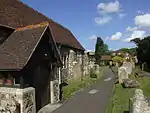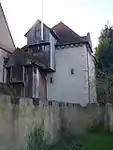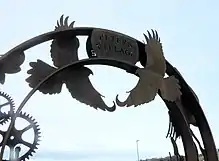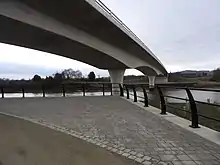Wouldham
Wouldham is a village on the bank of the River Medway in Kent, Great Britain. As of 2006 its population is approximately 1000 people, with the 11th-century church, one school, one village shop, and two public houses, The Medway Inn and The Waterman's Arms. The 3rd public house in the village- The Foresters Inn closed to the public in 2013.
| Wouldham | |
|---|---|
 Wouldham Location within Kent | |
| Population | 1,497 (2011 Census)[1] |
| District | |
| Shire county | |
| Region | |
| Country | England |
| Sovereign state | United Kingdom |
| Post town | Rochester |
| Postcode district | ME1 |
| Police | Kent |
| Fire | Kent |
| Ambulance | South East Coast |
| UK Parliament | |
History
The tusk and teeth of a mammoth were excavated in Peters Pit and displayed in Rochester Guildhall Museum. In 1982, the skull of an 18-year-old man was excavated- it was dated as 1500 BC and the museum staff have had the face reconstructed.[2] Oral history suggests that the village was occupied when the Romans arrived, and that they constructed a ford across the Medway. The site of a temple dedicated to Mithras has been excavated and occurs on old maps. On the Wouldham Marshes is Starkey House built in 1483: a now-restored Grade II listed medieval manor house called Starkey Castle.[3]
In the churchyard, is the grave of Walter Burke, who was present on board HMS Victory at the battle of Trafalgar and the man who held Nelson in his arms as he died. Wouldham school celebrates this connection with history in many ways, its four sports teams being named after ships at the Battle of Trafalgar (Victory, Ajax, Sovereign, Britannia), students being assigned into a house named after one of four famous figures at Trafalgar, which they are able to earn merit points for, and by holding an annual event at the nearby church to commemorate Walter Burke.
A narwhal was discovered in the 1940s washed up on the bank of the river,[4] and is documented in the Natural History Museum, London.
Until 1963 there was a ferry crossing over the Medway to Halling on the opposite bank.
 Entrance to Wouldham
Entrance to Wouldham Approach to Wouldham Church
Approach to Wouldham Church Wouldham Church
Wouldham Church Starkey Castle
Starkey Castle
Industry
For a hundred years, Wouldham was synonymous with cement. The Wouldham Court Cement Works was the earliest cement works opening in 1847. The works were based on the riverside in the centre of the village. In 1855, the first owners of the cement works, Thomas Freen and Co, became bankrupt and it passed in 1856, to the Wouldham Patent Portland Cement Co. They built a tramway to connect the works with the quarry, which was 1,380 ft away.[5] The tramline had six engines on it.
The Wouldham Hall Cement Works also fronted the river, and took in some land in Burham. William Peters started making hydraulic lime on the site between 1857 and 1866. He had 18 lime kilns.[6] The first wet process cement kilns were installed by the Peters Brothers in 1877.[7]
The cement started with bottle kilns, there were 24 in 1879, making 720 tons a week. The raw materials, were obtained on site and the finished product was taken to London in capacious Thames sailing barges, that would be about 5 barge loads. A photograph, in the care of Maidstone museum shows the waterfront with 11 moored barges. The Peters operation owned 80 barges, and employed 1000 men. In the 1880s these were replaced by Batchelor chamber kilns (each with a capacity of 30 tons per week)- and further were added to bring up the production to 990 tons per week. In 1898 seventeen more were added, and in 1903 thee Schneider kilns (at 330 tons) giving a total capacity of 1850.[7] The London demand for cement was voracious. Two Hoffmann kilns were installed, and then two rotary kilns. The first chamber kiln block was demolished, and the remaining chamber kilns were only used up to 1915, though six remained in commission until the sites closure.
The site was obtained by BPCM(Blue Circle) in 1911, who combined operations with the nearby West Kent works further along Hall Road. The works closed in 1925/26 for good. There was no railway on this side of the river, so getting to the railway at Snodland involved taking the cement by barge across the river and then hauling it by horse and cart. This was far uneconomical compared to the works across the river at Snodland, and Cuxton and Halling, with its rail connection to the Medway Valley line[8]
Peters Village

Before 1999, a large area of allotments were situated between the school and the recreation ground. Despite the opposition of many villagers,[9] a housing estate was built over them, which increased the village's population by a large percentage.
Peters Village is a new area of housing currently being constructed to the south of the existing village on the former Peters Wouldham Hall Cement Works and in Peters Pit. It consists of 1000 houses grouped in three sectors: the Village Centre, Lower Peters Village and Upper Peters Village. It includes a new primary school, community centre, playing fields cycle way and riverside esplanade together with a new road bridge across the River Medway. The site is sensitive as it lies adjoining a Site of Special Scientific Interest and the North Downs AONB.[10] The plans were approved in 2006 but postponed due to the economic downturn. Construction started on the infrastructure in 2014. The first apartments and houses were occupied in late 2017. The project, which received £19.5m from the government, is due to be completed around 2022.[11] The new crossing over the River Medway to link with the A228 road, the Peters Bridge, opened in September 2016. [8]

References
- "Civil Parish population 2011". Neighbourhood Statistics. Office for National Statistics. Retrieved 24 September 2016.
- "Wouldham - Bronze Age Man". www.wouldhamvillage.com. Retrieved 3 April 2018.
- "Starkey Castle, Wouldham". www.britishlistedbuildings.co.uk. 1 August 1952. Retrieved 21 October 2013.
- "Images of Medway Book - pd1364334". kentmessenger.newsprints.co.uk. 6 February 2008. Retrieved 21 October 2013.
- "Wouldham - Wouldham Court Cement Works". www.wouldhamvillage.com. Retrieved 3 April 2018.
- "Wouldham - Peters/Wouldham Hall Cement Works". www.wouldhamvillage.com. Retrieved 3 April 2018.
- Moore, Dylan. "Cement Kilns: Peters". www.cementkilns.co.uk. Retrieved 3 April 2018.
- Wouldham. "Wouldham - Peters/Wouldham Hall Cement Works". www.wouldhamvillage.com. Retrieved 3 April 2018.
- Smith, Alan (11 March 2014). "Huge majority say No to Wouldham allotment developments, reveals MP Tracey Crouch". kentonline.couk. Retrieved 11 August 2017.
- "Peters Village - Projects | Vincent & Gorbing". www.vincent-gorbing.co.uk. Retrieved 3 April 2018.
- BBC News, https://www.bbc.co.uk/news/uk-england-kent-27371752
External links
| Wikimedia Commons has media related to Wouldham. |
